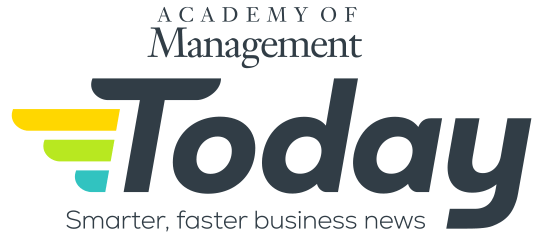By Daniel Butcher
Lack of pay equity can undermine an organization’s efforts to improve diversity and hurt the effectiveness of the leadership team.
Academy of Management Scholar Carol Kulik of the University of South Australia said that her research has found that in organizations that had pay gaps within their executive teams, as organizations added more women to executive teams, the companies’ financial performance actually went down.
“In other words, the firms are shooting themselves in the foot, as they’re trying to have more gender diversity in the senior team, but they simultaneously have this gender inequality in pay,” Kulik said. “They are sending a signal to the leadership team: ‘We’re putting women on the team, but we don’t value them as much,’ so as a result, the team doesn’t operate as effectively as it should.
“The leadership team isn’t able to take advantage of the gender diversity that it has,” she said. “I’m really proud of that research, because we often think about gender pay gaps as being a problem for women, but our research shows that gender pay gaps are a problem for women’s employers, that when they have gender pay gaps at the top, they’re actually making their whole executive team function less effectively.”
Women tend to be paid less than their male counterparts in the same leadership group, regardless of the quality of their respective performance. Kulik and fellow researchers suggest that the voices of these underpaid women exert less influence on the leadership team’s decisions and activities. Unheard and discounted, the women become demotivated and less engaged in the leadership team.
“It’s actually an interaction effect, so it’s not the gap itself that lowers performance; rather, it’s the exacerbating effects of the gap as you add more women to the team,” Kulik said. “So if you have one woman on the team, you’re probably not going to see that drop quite as strongly.
“But the more women you have on the team, the clearer it becomes that this is a function of gender, and not one person having less skills or less experience, the more it becomes clearly a gender gap,” she said. “And so that’s when it becomes a problem for the organization.”
A sample of Kulik’s AOM research findings:
-
Daniel Butcher is a writer and the Managing Editor of AOM Today at the Academy of Management (AOM). Previously, he was a writer and the Finance Editor for Strategic Finance magazine and Management Accounting Quarterly, a scholarly journal, at the Institute of Management Accountants (IMA). Prior to that, he worked as a writer/editor at The Financial Times, including daily FT sister publications Ignites and FundFire, as well as Crain Communications’s InvestmentNews and Crain’s Wealth, eFinancialCareers, and Arizent’s Financial Planning, Re:Invent|Wealth, On Wall Street, Bank Investment Consultant, and Money Management Executive. He earned his bachelor’s degree from the University of Colorado Boulder and his master’s degree from New York University. You can reach him at dbutcher@aom.org or via LinkedIn.
View all posts
Tagged #PayEquity #DiversityAndInclusion #EqualPay #WorkplaceFairness, bonus, bonuses, compensation, DE&I, equity, gender pay gap, inclusion, pay, pay gap, salaries, salary
Up next....
“Just Add a Woman and Stir” Is Not Enough for Board Success
By Daniel Butcher
Even at organizations that have made strides in adding women and people of color to their governing boards, tokenism is all too common. Diverse board members can’t make a difference if their longer-tenured colleagues routinely disregard their suggestions.
Academy of Management Scholar Kris Byron of Georgia State University said that female board members and those representing an ethnic or racial minority are often sidelined, technically part of the board but to whom the other directors or trustees don’t really listen.
Byron and research colleague Corinne Post of Villanova published an article on this topic in Academy of Management Journal.
“There’s this idea that you just add women and stir and that’s enough, but that’s not enough,” Byron said. “If we’re saying that the ways in which a woman might add value is that she might have different perspectives or a different lens through which to look at an issue, or she might have information or knowledge or experience that maybe some of her male colleagues don’t have.
“That knowledge, experience, and perspectives mean nothing—they’re not going to have any effect—if people aren’t willing to acknowledge the usefulness of that perspective or knowledge or experience,” she said. “There’s probably lots of other things that are important to whether or not the woman on the board is a token, or whether or not there’s some kind of critical mass of female directors on the board.
“Do people think, ‘Oh, she’s just there on the board because we had to fill this quota—she wasn’t the best person to serve in this role; she’s just here for window dressing to make us look good.’”
Diversity is hollow if it isn’t accompanied by equity, inclusion, and fostering a sense of belonging among members of marginalized and minority groups. Actually listening to female board members’ ideas and suggestions and enacting the best of them are crucial for them to have a chance to improve an organization’s leadership.
“There has to be this real belief among the other board directors that these women, that all of the directors, have some value-add, and that isn’t a given,” Byron said. “So that’s what it means that you can’t just add women and stir.
“There has to be some other things that are in place in order for women to have a positive impact on an organization, especially on something that’s so distal or downstream like firm performance,” she said. “Board directors largely have an indirect effect on organizational performance.”
-
Daniel Butcher is a writer and the Managing Editor of AOM Today at the Academy of Management (AOM). Previously, he was a writer and the Finance Editor for Strategic Finance magazine and Management Accounting Quarterly, a scholarly journal, at the Institute of Management Accountants (IMA). Prior to that, he worked as a writer/editor at The Financial Times, including daily FT sister publications Ignites and FundFire, as well as Crain Communications’s InvestmentNews and Crain’s Wealth, eFinancialCareers, and Arizent’s Financial Planning, Re:Invent|Wealth, On Wall Street, Bank Investment Consultant, and Money Management Executive. He earned his bachelor’s degree from the University of Colorado Boulder and his master’s degree from New York University. You can reach him at dbutcher@aom.org or via LinkedIn.
View all posts
Up next....
What Are the Effects of Adding Women to Boards? It’s Complicated.
By Daniel Butcher
Research shows that companies with more female directors can have better firm performance—and this is especially the case in countries that have stronger shareholder protections or that have greater gender equality. In addition, organizations whose boards have more female directors tend to be more engaged in activities that are central to boards’ responsibilities: monitoring and strategy involvement.
Academy of Management Scholar Kris Byron of Georgia State University said that board monitoring refers to the extent to which boards engage in activities that entail oversight of the firm and seek to control managers. Board strategy involvement refers to the extent to which boards engage in activities related to their advising role and decide how firms should compete in the marketplace.
Byron and research colleague Corinne Post of Villanova published an article on this topic in Academy of Management Journal.
“What we found was that there was a positive effect of adding women to the board on strategic involvement and a positive impact on board monitoring, but that board diversity is neither wholly detrimental nor wholly beneficial to firm financial performance,” Byron said. “There is some research showing that when you have more women on your board, they’re more likely to influence fellow directors’ or trustees’ behavior and that the norms of the board changes, for example, attendance gets better.
“There’s this spillover effect that women might have; maybe they come onto the board and they’re more diligent,” she said. “In some ways, that makes sense, because there aren’t tons of women who are in those kinds of senior positions, and so, if she got to that position, then she is probably quite exceptional and especially conscientious.
“Those behaviors may spill over to her male counterparts on the board, and there is research suggesting that that’s something that probably occurs.”
-
Daniel Butcher is a writer and the Managing Editor of AOM Today at the Academy of Management (AOM). Previously, he was a writer and the Finance Editor for Strategic Finance magazine and Management Accounting Quarterly, a scholarly journal, at the Institute of Management Accountants (IMA). Prior to that, he worked as a writer/editor at The Financial Times, including daily FT sister publications Ignites and FundFire, as well as Crain Communications’s InvestmentNews and Crain’s Wealth, eFinancialCareers, and Arizent’s Financial Planning, Re:Invent|Wealth, On Wall Street, Bank Investment Consultant, and Money Management Executive. He earned his bachelor’s degree from the University of Colorado Boulder and his master’s degree from New York University. You can reach him at dbutcher@aom.org or via LinkedIn.
View all posts
Up next....
The Gender Pay Gap Gets Worse Over Employees’ Careers
Source: Shutterstock
By Daniel Butcher
The gender pay gap between the earnings of male and female business professionals starts small on average but tends to grow over time.
“It’s so interesting that when we look at pay gaps among male and female MBA graduates coming out of the same program in the same year, the gap is so small; it’s really little initially,” said Academy of Management Scholar Carol Kulik of the University of South Australia. “But the problem is, it gets bigger every year, because the way we usually get people pay raises is we make it a percentage of their past salary, and so any sort of pay gap that you have in the first year after graduation gets a little wider, year after year.
“And women are still primarily responsible for caring for children and elderly family members,” she said. “And so they have these career gaps, where they step off the career ladder for a bit, and when they come back, they never quite catch up on the pay raises that the men in their cohort have gotten.
“By the time they get into executive roles, this gap can actually be really wide.”
Taking a step back, Kulik said that it’s important for leaders to recognize that there are gender pay gaps, even at the highest levels of organizations.
“From the public’s perspective, they say, ‘These are women at the top of their game, and companies are under so much pressure to hire women and have women represented in senior roles; surely, they can just negotiate a higher wage,’” Kulik said. “But you’re talking gaps of 20%—that’s a big ask when you’re going into one of these senior roles.
“I want to emphasize that the gap is big, and it’s really important to talk about it, especially because in executive roles, a lot of times the biggest part of your salary is not in the base salary; rather, it’s in all the discretionary bonuses that you get for good performance,” she said.
“The higher you get in an organization, the more subjective performance evaluations are, so it’s harder to tell when you’re a high-performer, and so we tend to see very big gender pay gaps among senior executives.”
A sample of Kulik’s AOM research findings:
-
Daniel Butcher is a writer and the Managing Editor of AOM Today at the Academy of Management (AOM). Previously, he was a writer and the Finance Editor for Strategic Finance magazine and Management Accounting Quarterly, a scholarly journal, at the Institute of Management Accountants (IMA). Prior to that, he worked as a writer/editor at The Financial Times, including daily FT sister publications Ignites and FundFire, as well as Crain Communications’s InvestmentNews and Crain’s Wealth, eFinancialCareers, and Arizent’s Financial Planning, Re:Invent|Wealth, On Wall Street, Bank Investment Consultant, and Money Management Executive. He earned his bachelor’s degree from the University of Colorado Boulder and his master’s degree from New York University. You can reach him at dbutcher@aom.org or via LinkedIn.
View all posts
Up next....
A Gender Pay Gap Solution Is Within Leaders’ Reach
Source: Shutterstock
By Daniel Butcher
Women working full-time, year-round are paid 84% of what men are paid on average, according to the U.S. Census Bureau. What is the answer to closing the gender pay gap? The solution might not be simple but is within leaders’ reach.
Academy of Management Scholar Carol Kulik of the University of South Australia said that the answer is auditing the compensation system and monitoring disparities within it.
“Data on the pay gaps that have just been released in Australia are company-wide, and what you really need to do is dig down and say, ‘At what level do we start to see pay gaps?’” Kulik said. “That’s so important, because when men and women come into an organization, the pay gap might be really small, but there could be at some critical stage in the future—maybe it’s at the point where they’re getting promoted into that first layer of management where there was a bigger difference. “You have to know where the problem is in order for you to really address it,” she said.
Role segregation is a significant aspect of the issue.
“We know that one of the big problems leading to gender pay gaps is role segregation,” Kulik said. “And that’s a really important thing for organizations to look at: whether women are concentrated in roles that don’t pay very well, are there some barriers that are keeping them from getting into some of the high paid jobs?
“One of the common examples that we use here in Australia is forklift operator—it turns out they get paid pretty well,” she said. “And women rarely apply for those jobs, because many organizations will require that you already have a license before you’re even considered for the role, but if the organization says, ‘We’ll provide some training to help you to get that license,’ we get much more gender balance in applications.
“And then we see a narrower gender pay gaps, because women now have access to roles that are higher paid—so there’s a lot of factors to consider.”
A sample of Kulik’s AOM research findings:
-
Daniel Butcher is a writer and the Managing Editor of AOM Today at the Academy of Management (AOM). Previously, he was a writer and the Finance Editor for Strategic Finance magazine and Management Accounting Quarterly, a scholarly journal, at the Institute of Management Accountants (IMA). Prior to that, he worked as a writer/editor at The Financial Times, including daily FT sister publications Ignites and FundFire, as well as Crain Communications’s InvestmentNews and Crain’s Wealth, eFinancialCareers, and Arizent’s Financial Planning, Re:Invent|Wealth, On Wall Street, Bank Investment Consultant, and Money Management Executive. He earned his bachelor’s degree from the University of Colorado Boulder and his master’s degree from New York University. You can reach him at dbutcher@aom.org or via LinkedIn.
View all posts
Up next....
Transparency Alone Doesn’t Solve Unequal Pay
Source: Shutterstock
By Daniel Butcher
Are pay-transparency laws the answer to fix the problem of women earning less than men? It’s complicated.
Academy of Management Scholar Carol Kulik of the University of South Australia said she would be reluctant to remove the discretionary part of executives’ pay packages, as performance bonuses have benefits and removing them wouldn’t necessarily close the gender pay gap.
“It is certainly true that in sectors that have less discretionary elements in pay packages, we tend to see smaller gender pay gaps,” Kulik said. “For example, in general, the pay gap in the public sector is smaller than pay gaps in the private sector.
“But I don’t think we want to say, ‘Just get rid of discretionary pay,’” she said. “Incentive pay is important for motivating effort and good performance, so we don’t want to remove that.”
Evidence does show that pay transparency narrows gender pay gaps. Several U.S. states and cities have pay-transparency laws, and in February 2024, the Australian government made information about individual companies’ gender pay gaps available for the first time. But rather than raising women’s pay, transparency often leads to compression of compensation toward the middle.
“Australia is getting on a bandwagon that we see in other countries, suggesting that one of the first steps you should take is find out how big the gap is, and to look at that requires pay transparency,” Kulik said. “But it’s really interesting to see what happens when countries have made pay gaps transparent; what we find is that, over time, pay gaps get narrower.
“But it doesn’t necessarily mean that women’s wages are getting higher; it often means that men’s wage growth is slowing,” she said. “If you’re an individual manager and you know that your pay decisions are going to get scrutinized, you become a little reluctant to pay anybody on the high end, so you start creating some compression at the top.
“Now, that’s not necessarily a bad thing, if you’ve got a pay system that’s really gotten out of whack, and you’ve got a few star performers who are really pulling the whole compensation system too far to the high end—on the other hand, you don’t want to eliminate all the motivating potential of your pay system because managers are reluctant to pay what it takes to recruit and retain top performers.”
A sample of Kulik’s AOM research findings:
-
Daniel Butcher is a writer and the Managing Editor of AOM Today at the Academy of Management (AOM). Previously, he was a writer and the Finance Editor for Strategic Finance magazine and Management Accounting Quarterly, a scholarly journal, at the Institute of Management Accountants (IMA). Prior to that, he worked as a writer/editor at The Financial Times, including daily FT sister publications Ignites and FundFire, as well as Crain Communications’s InvestmentNews and Crain’s Wealth, eFinancialCareers, and Arizent’s Financial Planning, Re:Invent|Wealth, On Wall Street, Bank Investment Consultant, and Money Management Executive. He earned his bachelor’s degree from the University of Colorado Boulder and his master’s degree from New York University. You can reach him at dbutcher@aom.org or via LinkedIn.
View all posts
Up next....
A Problem with Top Performers Becoming Managers
Source: Shutterstock
By Daniel Butcher
Managers may be excellent performers in their particular profession, but few have had formal training inleading teams, boosting performance, or dealing with a range of other human-resources issues they often face. That can be a problem given that line managers are a key link between rank-and-file employees and senior management and leadership.
Academy of Management Scholar Carol Kulik of the University of South Australia notes the irony of the fact that management roles are crucial for organizations, but it’s a job that most people don’t aspire to.
“I often ask my students or audiences, ‘What did you dream about your future job being when you were growing up?’ and as kids, when an adult would say, ‘What do you want to be when you’re an adult,’ nobody says, ‘A manager;’ nobody aspires to that role,” Kulik said. “If you become a manager, it’s because you’re really good at something else.
“We sometimes use the term ‘accidental manager,’ because it’s a role that people fall into, as opposed to aspiring to, and if you don’t aspire to it, then you don’t get trained in it, and you don’t even have that identity,” she said. “So a lot of people step into the manager role but didn’t anticipate it, so they haven’t sought out the opportunities to develop management skills.
“And as a result, they don’t even know what they don’t know about being a good, effective manager.”
A sample of Kulik’s AOM research findings:
-
Daniel Butcher is a writer and the Managing Editor of AOM Today at the Academy of Management (AOM). Previously, he was a writer and the Finance Editor for Strategic Finance magazine and Management Accounting Quarterly, a scholarly journal, at the Institute of Management Accountants (IMA). Prior to that, he worked as a writer/editor at The Financial Times, including daily FT sister publications Ignites and FundFire, as well as Crain Communications’s InvestmentNews and Crain’s Wealth, eFinancialCareers, and Arizent’s Financial Planning, Re:Invent|Wealth, On Wall Street, Bank Investment Consultant, and Money Management Executive. He earned his bachelor’s degree from the University of Colorado Boulder and his master’s degree from New York University. You can reach him at dbutcher@aom.org or via LinkedIn.
View all posts
Up next....
Gender Diversity in Senior Leadership Boosts Corporate Citizenship
Source: Shutterstock
By Daniel Butcher
Organizations don’t always appreciate the value that gender diversity in leadership roles can bring. Academy of Management Scholar Carol Kulik of the University of South Australia said that organizations have been reluctant to increase gender diversity in their senior leadership.
“We’ve put a lot of regulatory pressure on organizations to increase gender representation in senior levels.” Kulik said. “Some organizations respond to that pressure by doing the minimum; they’ll make a couple of appointments and then they are ‘one and done’ or ‘two and through.’
“However, having women in the leadership team can deliver major benefits to organizations,” she said. “We know that organizations that have more gender diversity in senior leadership are better corporate citizens.
“They’re less likely to engage in unethical behavior; they engage in more philanthropy and corporate social responsibility; they have smaller gender pay gaps; they offer more employee participation; they actually become better organizations.”
The effects of diversity in senior leadership aren’t as straightforward as many assume.
“It’s not because the women are so good on their own; it’s because anytime you have a decision-making group that has visible demographic diversity, they’re sitting around the boardroom and see there’s some men and there’s some women, the group acts differently,” Kulik said.
“The group automatically assumes that there are some hidden differences that they need to explore; they ask more questions, and they consider more solutions; they look at more data,” she said. “So they make more thoughtful and better decisions—it’s a really powerful effect.”
Kulik said that if leaders make organizations more inclusive and better for women and people with cultural and racial variations, then they’re actually creating better organizations.
“We see the same sorts of beneficial effects of diversity in any kind of decision-making group,” Kulik said. “And because of trickle-down effects, increasing diversity at a senior level increases diversity at lower levels too.
“So choose any level to start with and increase diversity at that level,” she said. “You’ll soon see more diversity at other levels and you’ll create a more inclusive organization.”
A sample of Kulik’s AOM research findings:
-
Daniel Butcher is a writer and the Managing Editor of AOM Today at the Academy of Management (AOM). Previously, he was a writer and the Finance Editor for Strategic Finance magazine and Management Accounting Quarterly, a scholarly journal, at the Institute of Management Accountants (IMA). Prior to that, he worked as a writer/editor at The Financial Times, including daily FT sister publications Ignites and FundFire, as well as Crain Communications’s InvestmentNews and Crain’s Wealth, eFinancialCareers, and Arizent’s Financial Planning, Re:Invent|Wealth, On Wall Street, Bank Investment Consultant, and Money Management Executive. He earned his bachelor’s degree from the University of Colorado Boulder and his master’s degree from New York University. You can reach him at dbutcher@aom.org or via LinkedIn.
View all posts
Up next....
The “Lone Genius” Myth Overshadows One of the Partners
Source: Shutterstock
By Daniel Butcher
Professional creative partners—such as Lennon and McCartney, Rodgers and Hammerstein, the Coen brothers, and Jerry Seinfeld and Larry David provide evidence that the pair is the primary creative unit. But countless examples show when one of a pair gets more credit than the other—think Duke Ellington and Billy Strayhorn, Dave Chappelle and Neil Brennan, Simon and Garfunkel, as well as whoever was the wind beneath Bette Midler’s wings.
Academy of Management Scholar Bess Rouse of Boston College said that many organizational stories feature duos who create together:
• Steve Jobs and Steve Wozniak propelled the personal computer revolution.
• Sergey Brin and Larry Page provided new ways to find information through Google.
• Ben Cohen and Jerry Greenfield shifted our expectations about ice cream with flavors such as Cherry Garcia and Phish Food.
Such creative pairs often start their own companies, but when they work within organizations, they change them.
“We have this very this myth of the lone genius—this is woven through the creativity literature where we really want to assign credit to one person,” Rouse said. “This idea can be very rupturing to a creative dyad, if somebody’s trying to assign more credit to one than the other or saying, ‘This is really that one person’s idea—that other person didn’t do very much.’
“Our societal and organizational incentives—both financial rewards and recognition—are generally not aligned well with this idea that we actually do creativity as a very social process,” she said. “It isn’t just in entertainment and business; also in medical fields, an important question is, ‘Who came up with what discovery?’ and we’ve gotten a little looser on attribution of credit, being able to say, ‘This team of people came up with this discovery,’ but often you will hear people still continue to pick apart who did what and say, ‘That was really this one person’s idea, and this other person was just helpful.’
“I don’t think we’ve figured out a very good way of rewarding or acknowledging the power that happens in a group or particularly in a dyad around creativity—we still really want to assign ownership or credit to one person.”
In some cases, different personality types determine which half of a duo is more celebrated by the media.
“You definitely see these examples where there’s one person in a duo who becomes a media darling, and sometimes this is by choice, when one person likes being in the spotlight more than another person, and they’re willing to fly under the radar, like Steve Jobs and Steve Wozniak,” Rouse said.
“You can think about social dynamics there, and in some situations, one person loves being in front of the camera and getting those kinds of accolades, and another person would prefer to be in the background,” she said.
“But sometimes it isn’t an individual choice—that is, there are other factors that come into play that shape who we pay attention to.”
-
Daniel Butcher is a writer and the Managing Editor of AOM Today at the Academy of Management (AOM). Previously, he was a writer and the Finance Editor for Strategic Finance magazine and Management Accounting Quarterly, a scholarly journal, at the Institute of Management Accountants (IMA). Prior to that, he worked as a writer/editor at The Financial Times, including daily FT sister publications Ignites and FundFire, as well as Crain Communications’s InvestmentNews and Crain’s Wealth, eFinancialCareers, and Arizent’s Financial Planning, Re:Invent|Wealth, On Wall Street, Bank Investment Consultant, and Money Management Executive. He earned his bachelor’s degree from the University of Colorado Boulder and his master’s degree from New York University. You can reach him at dbutcher@aom.org or via LinkedIn.
View all posts
Up next....
Taming Toxic Workplaces
Source: Shutterstock
By Daniel Butcher
If you work for a bad boss at a dysfunctional or toxic organization, you can either find a new job or learn to cope with stressful conditions. But if you can get middle managers on your side, then you might even be able to start changing the toxic culture.
Academy of Management Scholar Bess Rouse of Boston College, who coauthored an Academy of Management Journal article with William Kahn of Boston University on this topic, said that toxicity appears in organizations as intolerance, bullying, narcissism, and other forms of destructiveness that demoralize employees and undermine organizational success. Senior leaders often perpetrate toxicity or fail to stem destructive behaviors.
“How do the people working underneath these intolerant, narcissistic, or destructive leaders respond in these toxic situations?” Rouse said. “It isn’t uncommon for me to talk to somebody who feels like they have one of these toxic leaders that they’re working under, but they don’t always have an idea of how to handle it.
“One option is to just leave, but we don’t always have that option to just leave, so then we think about, ‘How do we want to be? What kind of middle manager, if we’re in that position, do we want to be?” she said. “Do we want to be somebody who protects ourselves and has that toxicity cascade down the organization, or do we want to be somebody who buffers our employees and makes them feel protected?
“There are different ways of thinking about coping with a toxic workplace; we talk about this as workarounds for how you think about responding to those toxic leaders.”
Toxic organizations drain workers’ personal agency, undermining their capacity to act independently and make choices.
“Leaders’ toxic behaviors such as intolerance, bullying, narcissism, and destructiveness are all red flags, and we can be good leaders without having those behaviors,” Rouse said. “What we saw in that study was that these weren’t bad people—they were driven by anxiety about a lot of external challenges that were happening in the organization, and they just managed that anxiety by belittling other people and diminishing them.
“Obviously it wasn’t the most effective way, but that was their way of dealing with that pressure, and then we also found that that stayed in place because the senior team colluded around that, essentially, and no one stepped up and said, ‘We can’t keep behaving this way,’” she said. “It was actually the middle managers, those people who were better at shifting from absorption to differentiating among team members, which ended up challenging that structure in that type of toxic organization.
“Especially when that that top leadership team has become very insular and supporting of one another in a way that there are no new voices coming into that senior team, then the middle managers are left to have to do that that work of changing the toxic organizational culture.”
-
Daniel Butcher is a writer and the Managing Editor of AOM Today at the Academy of Management (AOM). Previously, he was a writer and the Finance Editor for Strategic Finance magazine and Management Accounting Quarterly, a scholarly journal, at the Institute of Management Accountants (IMA). Prior to that, he worked as a writer/editor at The Financial Times, including daily FT sister publications Ignites and FundFire, as well as Crain Communications’s InvestmentNews and Crain’s Wealth, eFinancialCareers, and Arizent’s Financial Planning, Re:Invent|Wealth, On Wall Street, Bank Investment Consultant, and Money Management Executive. He earned his bachelor’s degree from the University of Colorado Boulder and his master’s degree from New York University. You can reach him at dbutcher@aom.org or via LinkedIn.
View all posts
Up next....
Why Some People with Mental Disorders Thrive as Entrepreneurs
Source: Shutterstock
By Daniel Butcher
Symptoms and traits associated with certain mental disorders, including attention deficit/hyperactivity disorder (ADHD), bipolar disorder, dyslexia, and autism, may help entrepreneurs and other businesspeople succeed, noted Academy of Management Scholar Dean Shepherd of the University of Notre Dame.
Shepherd said that conditions that might be seen as a negative, particularly in employment, can sometimes be an advantage in entrepreneurship.
“Some mental disorders are perceived to negatively impact reliability in traditional nine-to-five employment but can actually be an asset in entrepreneurship,” Shepherd said. “Research has found that people with dyslexia tend to have weaker aspects in their left hemisphere of their brain, but their right hemisphere is stronger, and so therefore they can enter entrepreneurship and be successful in it.
“We have the statistics to say that the people with dyslexia are more likely to become entrepreneurs than the general population—in fact, it’s true for many groups who feel like they’re constrained in being promoted in corporate employment turned to self-employment or entrepreneurship,” he said.
“That includes minorities, marginalized groups, and people with all sorts of disabilities, for example, women and immigrants, because they feel like they have constraints or face discrimination in the workplace and that they don’t have those as much in entrepreneurship.”
Research has found that people with ADHD are more likely to become entrepreneurs.
“People with ADHD are more prepared to engage in risk taking, they’re more proactive, and they’re more innovative, and we also found that people with autism are actually getting used by companies engaging in software testing, because they have some advantages in being able to test software,” Shepherd said.
“Entrepreneurship may cause some mental disorders through high stress or loss when a business fails, which can be an important point to consider when deciding on your career path, but people with disorders are also drawn to entrepreneurship,” he said.
-
Daniel Butcher is a writer and the Managing Editor of AOM Today at the Academy of Management (AOM). Previously, he was a writer and the Finance Editor for Strategic Finance magazine and Management Accounting Quarterly, a scholarly journal, at the Institute of Management Accountants (IMA). Prior to that, he worked as a writer/editor at The Financial Times, including daily FT sister publications Ignites and FundFire, as well as Crain Communications’s InvestmentNews and Crain’s Wealth, eFinancialCareers, and Arizent’s Financial Planning, Re:Invent|Wealth, On Wall Street, Bank Investment Consultant, and Money Management Executive. He earned his bachelor’s degree from the University of Colorado Boulder and his master’s degree from New York University. You can reach him at dbutcher@aom.org or via LinkedIn.
View all posts












